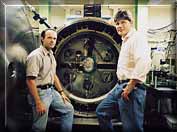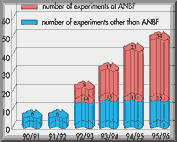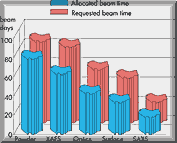The Australian National Beamline Facility at the KEK Photon Factory
Towards the end of the 1980s, a core group of Australian researchers who made regular use of synchrotron radiation (SR) in their research programmes began devising a plan which would for the first time open the field of SR to all Australian researchers by providing a mechanism for routine access to a state-of-the-art facility such as the Photon Factory here at KEK (KEK PF).
Through their efforts in lobbying the Australian government and the generosity of the Photon Factory management, the Australian National Beamline Facility (ANBF) came into being. The ANBF in its current form is a collaborative research project between the KEK PF and the Australian Synchrotron Research Program (ASRP). The ASRP is funded by the Australian government directly under the Major National Research Facilities programme and includes with the ANBF an Australian involvement with three Collaborative Access Teams (CATs) at the Advanced Photon Source (APS) at Argonne National Laboratory in Chicago, USA.

The ANBF has two full-time staff members based permanently at KEK - Dr. Garry Foran, the Project Leader (picture right) Dr. James (call me Reg) Hester (picture left) who recently joined the ANBF after four years working at another institute in Tsukuba (NIRIM). Reg replaced the much-loved Dr. David Cookson who is still working for the ASRP but is now part of the ChemMat CARS CAT at the APS.
The ANBF has been operational at KEK since 1993 and currently hosts about 40 experimental groups per year at beamline BL-20B. The groups cover a wide range of scientific interests including physics, chemistry, materials science, mineralogy, biology and biomedicine (See below for more details). In addition, the ANBF collaboration with KEK has led to an increased usage of other beamlines at KEK PF by Australian research groups. Currently about 15 experimental teams per year make use of the Photon Factory beamlines other than the ANBF.
 |
| Number of Australian experiments conducted at KEK PF by financial year. |
Beamline Description
TBecause the ANBF serves such a wide range of scientific disciplines with many and varied demands, it is by nature a multi-purpose facility providing monochromatic or “white beam” photons in the Hard X-ray range (4 - 25 keV) for use by the experimenters. Two experimental stations are available at the ANBF. The main station is a multi-configuration two-circle diffractometer which is mounted inside a large vacuum chamber. The instrument is designed to operate in a conventional scanning mode of data collection but is optimized for high-speed data collection using X-ray imaging plates (IPs). The main technique for which this instrument is used is high-resolution powder diffraction in which the X-ray diffraction patterns of powdered, polycrystalline materials are measured and then used to determine atomic level structure. A complete high-resolution data set for a single sample can be collected in a matter of minutes using this instrument, compared to the many hours of scan time required for a conventional laboratorybased diffractometer.
In addition, the diffractometer can be operated in a time resolved mode which makes it suitable to study dynamic processes and phase transitions. The unique combination of IP detection and vacuum operation of the diffractometer makes it suitable for a number of other techniques. It can be configured for grazing-incidence diffraction to study thin films and surfaces, triple-axis diffraction and small angle scattering which has found popular application in the study of natural fibres of animal and human origin.
 |
| Beamtime allocation by xperimental technique in 1995 and 1996. |
The second experimental station at the ANBF is an optical table which is used primarily for Xray absorption experiments (XAFS) but can be configured also for optics and imaging experiments. An extensive range of detection equipment is available for XAFS experiments including a 10 element germanium solid-state advanced array detector. A recently-acquired closed-cycle helium refrigeration system has increased our capabilities further in this active application of SR. Currently, XAFS and powder diffraction make up about two thirds of the experiments performed at the ANBF.
Back to the Future
After more than five years of operations at the ANBF, the facility continues to mature and attract new and interesting scientific problems both to BL-20B and the PF as a whole. While demand for beamtime at the ANBF is now considerably beyond what can be supplied, it is hoped that the ANBF can continue to grow by concentrating effort into “untapped” Australian markets such as those research groups that require SR in the vacuum ultraviolet (VUV) and soft X-ray ranges.
Thanks to the hard work of the ANBF staff members and the support of the research, administrative and, not the least, the technical staff of KEK, the project has proved to be a great success and stands proud as a model for fruitful and mutually beneficial international scientific collaborations. The ANBF maintains it’s own office at the PF and can be contacted anytime by the following media.
Tel : +81 298 64 7959
Fax : +81 298 64 7967
www : http://anbf2.kek.jp/
email : foran@anbf2.kek.jp (Garry Foran), jrh@anbf2.kek.jp (James ‘Reg’ Hester)
